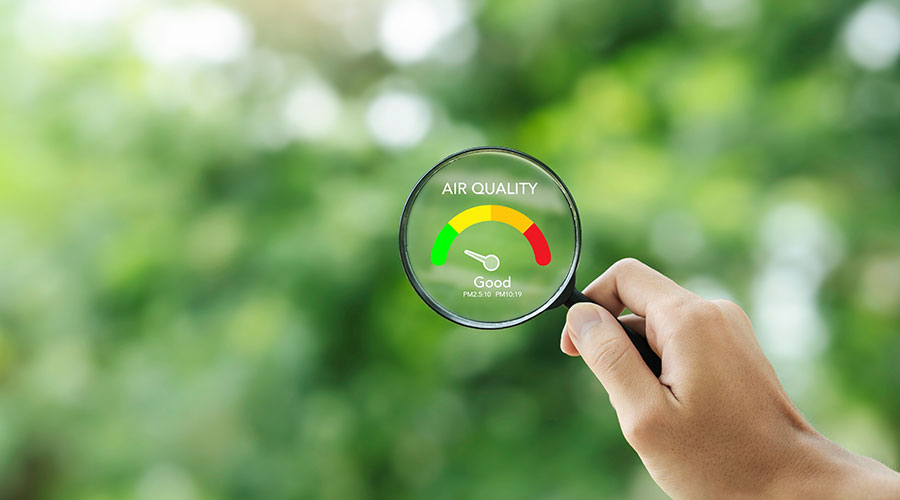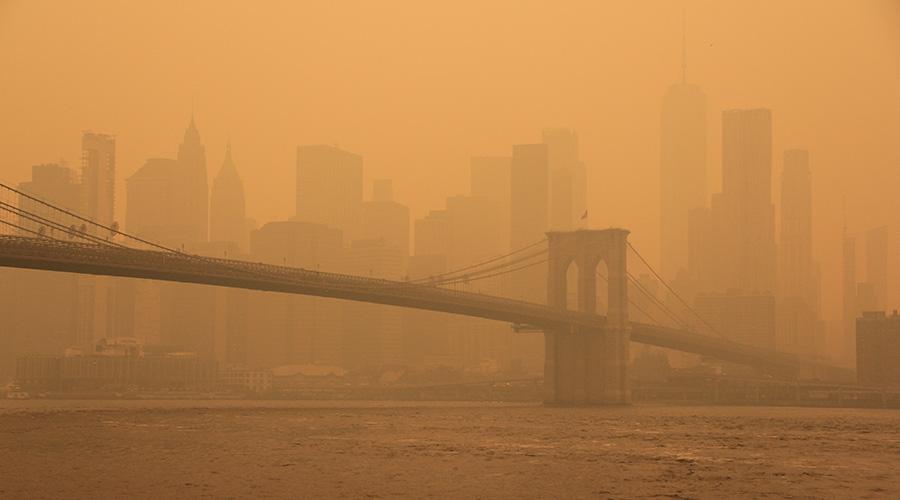Air Filtration Can Make Breathing Easier
Selecting an air filtration system with the right level of efficiency for a particular building type can increase indoor air quality and help create a healthy facility
In the past, air filtration systems in spaces such as offices and schools were designed primarily to protect HVAC equipment and reduce the need for facility cleaning. In recent years, people have become aware of the issue of indoor air quality as independent studies have focused attention on the deleterious effects of airborne contaminants and the relationship of “sick building syndrome” to higher absenteeism and lower productivity. In turn, facility executives have felt increasing ethical, legal and marketing pressures to provide a high-quality indoor air environment for their occupants.
Air filtration systems aim to capture, in a cost-effective manner, as many of the suspended particulates, biological materials and gases from the air as possible. An air filtration strategy depends on the building’s occupancy, location, specific air quality issues, and the type and operation of the HVAC system. For example, the strategy for an airport terminal, which is subject to high volumes of diesel and jet fuel gases, differs from that of a typical office building.
Rating the Ratings
Filters are rated based on a minimum efficiency rating value (MERV). Normal filter types range from low efficiency (MERV 8) to medium efficiency (MERV 13) to high efficiency (MERV 15). (See box on page 14.) MERV 13 or MERV 15 filters are effective for most commercial and institutional applications.
Facility executives should balance air filtration efficiency with operating cost, which basically comprises filter costs and the cost of electricity to power the air handling system.
Low-efficiency filters cost approximately $50 each. High-efficiency filters cost roughly $140 each. HEPA filters range in cost from $180 to $500 each.
Pressure drop is one of the factors in the operating cost equation. Pressure drop is the measurement, in inches, of the decrease in air flow through the filter compared to no filter. Pressure drop is affected by MERV, dust loading and fan velocity. The higher the MERV, the greater the pressure drop across the surface of the filter. Similarly, as the filter accumulates particles, the pressure drop increases, resulting in decreased air flow through the filter. For example, at the recommended velocity of 500 fpm, the initial pressure drop of a new filter when the fan is running at maximum velocity is approximately 0.35 to 0.75 inches for a MERV 13 filter, 0.85 to 1.0 inch for a MERV 15 filter, and 1.0 to 2.0 inches for HEPA filters.
It might seem that the higher the MERV rating, the higher the operating cost because of the higher initial and replacement costs of the filters, plus the cost of power to operate the higher horsepower fans required to push the air through the filters.
But it’s more complicated than that.
Consider a comparative analysis of operating costs for medium efficiency versus high efficiency filters in a commercial office building. Most office buildings use variable air volume systems, and, depending on the building’s location, fans operate, on average, at 70 to 90 percent volume. The filters are at their highest pressure drops at maximum volume, thus the difference in operating costs between medium-efficiency and high-efficiency filters will be greater in a building in which the fans average 90 percent volume than in a building in which fans average 70 percent.
Regardless of the efficiency of the filter, operating cost is quite specific to the building; there is no rule of thumb. This means the type of filter should be selected based on the specific building location, occupancy, air quality issues and type and operation of the HVAC system. However, it is reasonable to specify a filter of at least MERV 13 to maintain good indoor air quality in common types of spaces. At 85 percent efficiency, the pressure drop is generally less than 0.50 inches, which can be handled by most existing air handling systems. If an owner is considering a higher efficiency system, a life-cycle analysis is strongly recommended to compare benefits against increased operating costs.
High Efficiency Filtration
High-efficiency-particulate air (HEPA) and ultra-low-penetration air (ULPA) filters have efficiencies ranging from 95 percent at 0.3 microns to more than 99.99999 percent at 0.12 microns. HEPA filters are widely used to control allergens and microbes in hospitals and laboratories, in sensitive manufacturing facilities and in facilities requiring protection from agents of bioterrorism. ULPA filters were developed in the early 1960s for use in the microelectronics manufacturing industry, where they are still used today.
Typically, a HEPA or ULPA filtration system uses lower efficiency filters as “pre-filters” to capture some of the particulates before the air reaches the final stage of filtration. That setup extends the life of these expensive filters.
Carbon filters, which adsorb odors and gases, are primarily used in airports and highly specialized industrial applications. They are not only expensive, but also have a very high pressure drop, so they are limited to applications with a maximum air flow of 200 fpm. This requires mechanical units to be sized accordingly, that is, 2.5 times larger.
Electrostatic filters create an electrical charge in the air, causing particles to attach not only to the filter, but also to one another, forming heavier particles that drop out of suspension. These are effective in controlling allergens and tobacco smoke, but care must be taken to specify a type that does not generate ozone, which is harmful to the respiratory system. These are rarely used in commercial applications because of increasingly common bans on smoking, but they are used in a number of large airports.
Current Practices
Most modern Class A office buildings use filters rated MERV 13 or higher. Building owners realize that this translates to higher operating costs. However, they can market a high-quality indoor environment, justifying higher lease rates. At the same time, the owner’s potential liability drops.
More schools should be equipped with MERV 13, if not MERV 15 filters, plus ultraviolet (UV) light sterilization because of children’s susceptibility to respiratory infections and the effects of pollutants. UV units that emit type C light could be incorporated into the air handling system just behind the air filters, reducing biological pathogens both in the air and on the filters themselves.
In contrast, because of the largely transient nature of the occupancy, most retailers tend to use lower efficiency air filtration systems, unless higher efficiency filters are required to protect their merchandise.
Health care facilities are a special case. Hospital codes require HEPA filtration for critical areas, such as operating rooms, other invasive procedure rooms, infectious disease isolation rooms and emergency room waiting areas.
Ali Sherafat, P.E., is a senior vice president in the Los Angeles office of Syska Hennessy Group, a consulting, engineering, technology and construction firm.
Basics of Air Filtration
In the past, the American Society of Heating, Refrigerating and Air-Conditioning Engineers (ASHRAE) standards defined air filter efficiency as the percentage of airborne particles larger than 1 micron captured by a filter; for example, 30 percent, 80 percent or 95 percent.
The new ASHRAE Standard 52.2 — which defines the MERV scale — assigns a value for the filter’s minimum efficiency in capturing particles at six progressive stages of dust-loading with particles in the range of 0.3 to 10 microns. Comparing the new standard with the old, for example, a filter rated MERV 8 will capture roughly 30 percent of 1-micron particles at maximum dust-loading; MERV 13, 80 percent; and MERV 15, more than 95 percent.
A filtration system consists of a filter frame, filter pack, separators, filter media and sealants. Media are the filtering materials, usually paper, that is pleated to increase surface area and fit into the desired space. Separators support the filter media and provide channels through which the air can flow to reach the filter. The filter pack contains the media and separators.
Sealants create a leak-proof seal between the filter pack and the filter frame, which contains the whole assembly. Sealants are an important component to the proper functioning of the filtration system. For example, a decision may be made to replace existing low-efficiency filters with high-efficiency filters in existing filter frames. However, the existing sealant may not meet the requirements of the higher-efficiency filters, and a portion of the air may be drawn through the weak seals rather than the filter itself.
Filtration systems are sized in square feet according to the velocity of the air flow, generally 1 square foot of filter per 500 cfm air flow. Consider an office building that averages 1 cfm per square foot of floor space. Therefore, every 1,000 square feet of office space requires 2 square feet of filter, and a 100,000 square feet office building requires a total of 200 square feet of filter area.
|
Related Topics:











